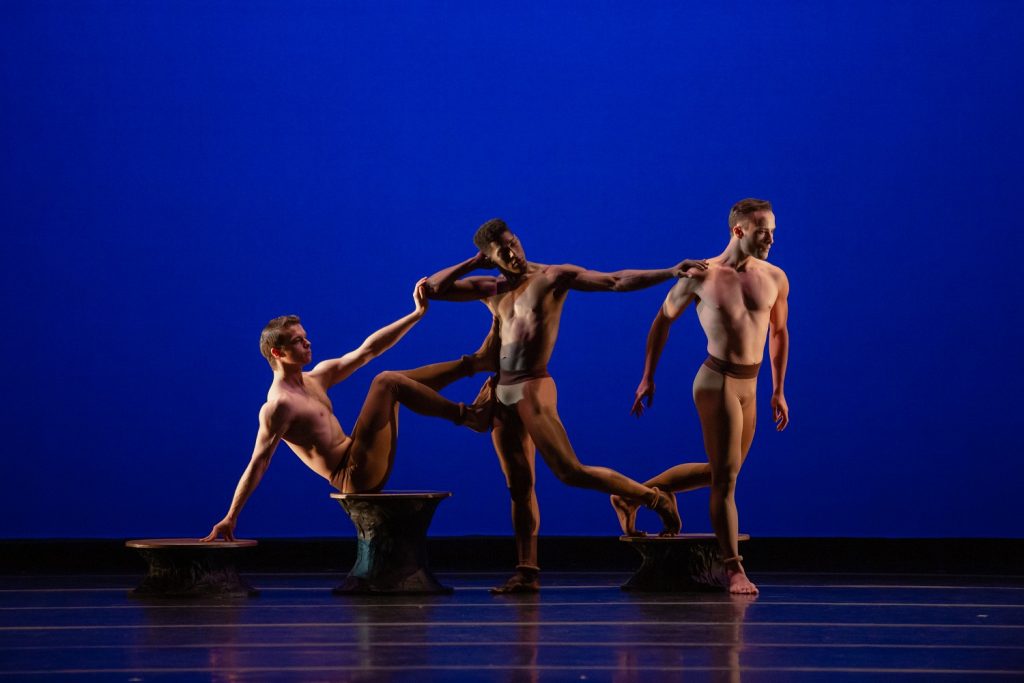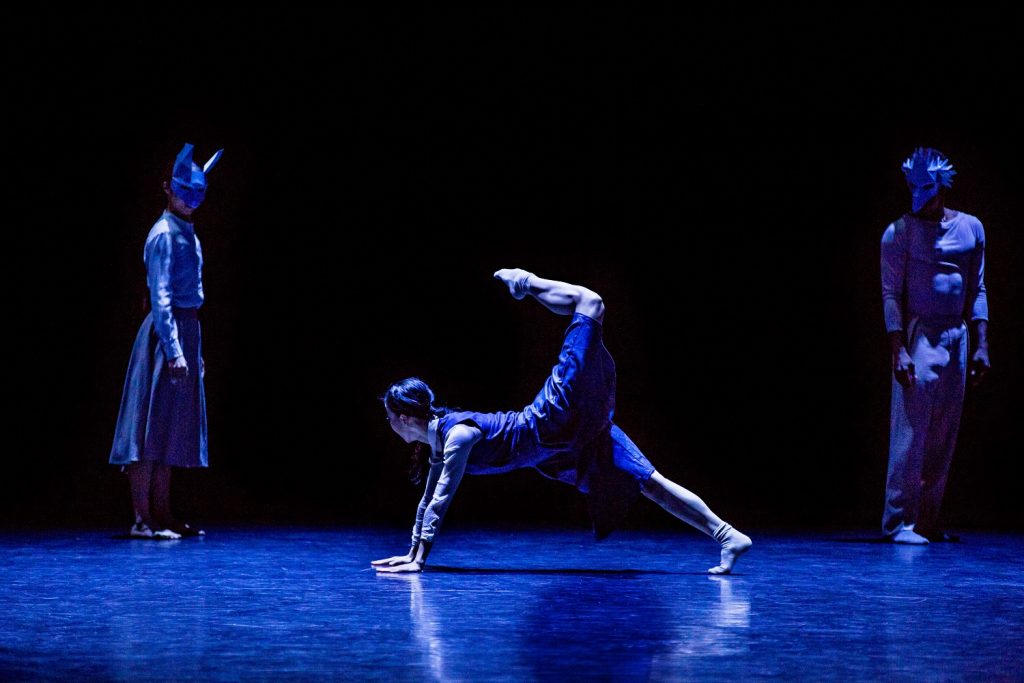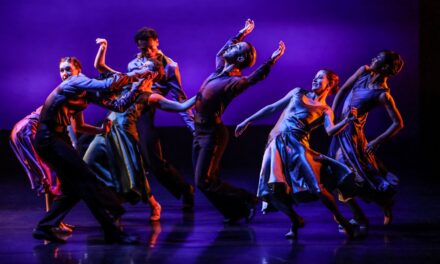The Martha Graham Dance Company under the steady and dedicated work of Janet Eilber, Artistic Director since 2005, launched their two-year initiative, The EVE Project on March 2, 2019 at the Younes and Soraya Nazarian Center for the Performing Arts in Northridge. This performance celebrates the upcoming 100th Anniversary of the passing of the 19th Amendment, the women’s power to vote.
It was a dazzling melding of the Graham Company and wild Up’s 32-year-old conductor Christopher Rountree. The choice to partner the young with the classic, honoring not only Martha Graham, the “Picasso of Modern Dance,” and her brilliant work, but melding the energy and ideas of a new generation of genius, both in music, dance and art. As Eilber made sure to remind us, this is something that “Martha” would have loved. It now moves the 92-year-old company (the oldest American Dance Company) into the future, recognizing young brilliant creators like Rountree, Pontus Lidberg, Caroline Shaw and Pam Tanowitz.
The evening began with a tribute and remembrance of the great words of our statesmen and literary leaders, with essential American texts of our Founders, with Abraham Lincoln, Maya Angelou, Martha Graham and Emma Lazarus’ impassioned reminders to us all. Graham’s AMERICAN DOCUMENT originally premiered in August 1938 in response to rising Fascism in Europe. It was performed at the Vermont State Armory, in Bennington, Vt.; originally featuring Erich Hawkins, Graham’s first male company member and eventual husband, along with such luminaries as May O’Donnell, Jane Dudley, and Sophie Mazlow. It was again reconstructed in 1989, 2010, and now in 2019, reimagined by Oliver Tobin. It paired spoken word with movement, and reclaims the timely question “What is America?” Tobin’s moving reworking was paired with the students of California State University-Northridge, with the help of rehearsal lead Elissa Brock.
Eilber explains, “Martha, in her early work was sampling American pieces [asking] ‘who are we as a country.’” On stage with drums pulsating and music by William Schuman, the diverse voices of today look to the mission of the past and the future “Give me your tired, your poor, your huddled masses, yearning to breathe free.” The intertwining of levels, rhythms, silences and purpose, was movingly performed by the 20 students as a tribute to Graham’s legacy and the Power of wo/men in building this country.
Then with a jocular transition we move to SECULAR GAMES, the second piece of the evening, which was done in 1962 and is Graham’s look at the simple enjoyment of life, love and games played in pursuit of one sex to another, and with each other. It was created in an era of sexual exploration and politics.
The tongue-in-cheek use of props to create physical connection in the all-male opening of the piece, shows the contest and one-upmanship, the moves, the execution, the strutting, then posing, so reminiscent of the ancient frieze, and Graham’s appreciation of Greek antiquities.
Graham’s observation of the “Socratic” environment is soon broken by the introduction of “Woman” in the humorous, “Utopian Island.” Eventually, after much trading of places, it moves to the third piece… “any island.” It is a delight-filled romp with wonderful mindless antics and pure dance, humorous insights of sexual gamesmanship and the nature of the human animal.
WOODLAND, created in 2016, and choreographed by Pontus Lidberg, Swedish choreographer, filmmaker and dancer, is a compelling mixture of architecture both physically and emotionally. Lidberg’s choice of one of the building blocks is the remarkable and facile Marzia Memoli, who is technically brilliant, powerful with dramatic effortlessness, and an understanding of the deeper message without being maudlin. She is stunningly supported by the ensemble of brilliant Graham dancers, Alessio Crognale, Laurel Dalley Smith, Lloyd Knight, Charlotte Landreau, Lloyd Mayor, Anne O’Donnell, Lorenzo Pagano, and Leslie Andrea Williams.
Lidberg has built this dazzling piece with the music of Irving Fine, a contemporary of Virgil Thomson and Aaron Copeland. Then taking on his filmic sensibility, he constructs the geometry of shapes, dimensions and levels with extraordinary clarity, expressing his imaginings under moonlit night with lighting design by Nick Hung. He expresses how creatures pair and move in packs, where isolation and relationships are vital to survival. That need to connect, that generosity of spirit in the work, makes this a thrilling and moving piece that is a perfect pairing with the evening of Graham.
This World Premiere piece by Pam Tanowitz, aptly named “Untitled,” fights to be meaningful by taking on and reimaging Graham’s work. Tanowitz explains that it is “inspired by old Graham dances.” Like much dance today, it tends to be better on paper and in the head than realized on stage. The dancers, willing as they may be, are attempting to find the message and therefore finding the purpose of the piece.
The music is outstanding by Caroline Shaw, moving in and out of recognizable classical phrases by Beethoven and other greats. There are moments of silence – holding us in hopeful expectation. It never quite comes to fruition. It is a work in progress and perhaps will expectantly find its way up the summit to the quality of the evening.
CHRONICLE, Graham’s chilling work of art and the final piece of the evening, uses Wallingford Reigger’s emotionally wrought musical score with the original lighting by Jean Rosenthal, so brilliant and economical.
CHRONICLE is divided into three sections; SPECTRE 1914 is the apparition of World War I. The un-self-conscious and menacing opening with the powerful movements of Xin Ying with her blood red and black shroud soaring nearly seven feet in the air, designing arcs and circular patterns and finally wrapping her entire body in flaming crimson. Her defiance so great as to give the appearance of slowly levitating beyond her body and then, without warning, throwing herself flat on the naked stage. Seeing and feeling this brilliant performer stunned the audience into silence. Ying’s performance was unstoppable and powerfully compelling.
Graham saw clearly the menace of Fascism when the boots marching in the streets could no longer be ignored.
The second movement Steps in the Street begins with one soul, played by the incredible Anne Souder dressed in black. She backs onto the stage; step, drag, hesitate, step drag, hesitate, all in silence. This remarkable section, comments on the devastation of people caught in war. The stunning use of tiny runs, continuous jumps, and reconfigurations, static against kinetic, calls for the dancers to defy gravity and rise to all manner of challenges which this piece demands. Their sudden heroic prowess surprises and adds to the tension and release of this remarkable piece.
And finally, …
Prelude to action, is the third and final movement with
Xin Ying and Anne Souder leading this tour de force. Together they lead the company in the last movements of “Unity” and, “Defining the future.”
With incredible invention and repetition, Graham’s choreography creates and builds astonishing tension and artful aesthetics throughout the whole evening. It then crescendos so effectively as to become heroic. The Graham Company, if continuing this trajectory, leaves a legacy that will inspire and be known as one of the great companies of our time. Congratulations Janet Eilber and all those who have helped with the survival and success of this magnificent and brilliant Graham legacy. It’s a reminder that art and beauty does exist with us today.
For more information on the Martha Graham Dance Company, click here.
For more information about the Younes and Soraya Nazarian Center for the Performing Arts, click here.
Featured image: Photo of Xin Ying (soloist) and Martha Graham Dance Company in Martha Graham’s Chronicle – Photo by Melissa Sherwood
















A great review Joanne and your research is impeccable. So glad I got to share this performance with you.
Hugs, Cheryl